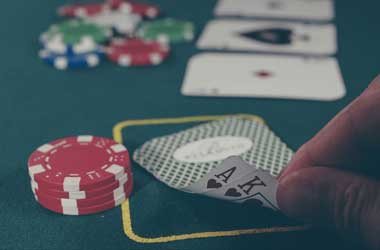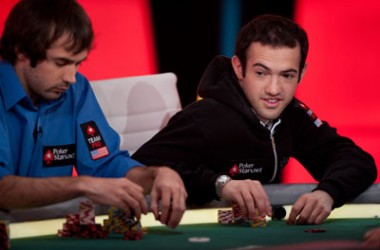 Poker, in all of its different forms, brings forth exciting game play and a thrilling option in the gambling world overall. However, just as there are different types of poker variations, there are different types of poker players. Subsequently, this means that there are different types of poker play too. The one thing that binds them all though, is that they can all be put to use in any poker situation. As long as you can read the cards, read your opponents and understand the hands, you can adjust your specific play as necessary. These types of poker play are what we’re going to look at here, so that you can become familiar with them. Perhaps you can then figure out how your opponents are playing and utilise your own poker play accordingly.
Poker, in all of its different forms, brings forth exciting game play and a thrilling option in the gambling world overall. However, just as there are different types of poker variations, there are different types of poker players. Subsequently, this means that there are different types of poker play too. The one thing that binds them all though, is that they can all be put to use in any poker situation. As long as you can read the cards, read your opponents and understand the hands, you can adjust your specific play as necessary. These types of poker play are what we’re going to look at here, so that you can become familiar with them. Perhaps you can then figure out how your opponents are playing and utilise your own poker play accordingly.
Keep in mind that there isn’t a single method of poker play that you should use from beginning to end. Instead, the different options should be brought into a game when you figure out how your own hand looks and potentially, how other players’ hands also may look.
Aggressive Play
If the term “aggressive” play is brought up, this usually relates to ‘opens’ and ‘raises’. Naturally, this relates to the wagering part of the game. So, if someone chooses to open the betting at a high rate, or following on from this decides to raise the stakes, then it’s considered to be aggressive play. On the other hand, ‘calls’ and ‘checks’ are considered to be at the other end of the spectrum. Keep in mind that a check-raise is actually an extremely aggressive form of play. Aggressive poker play may sound like something for someone who is hot-headed, but it can be quite beneficial. It often means that money can be made on weaker hands due to the potential for aggressive bluffing. Of course, a player who is constantly aggressive throughout a poker game will become too predictable, as with any form of play.
Bluff Play
A player who utilises a bluff is usually considered to have a bad hand or a weaker hand, but still goes for a bet or a raise. This is to try and force other players to fold, despite them having the stronger potential to hold a better hand. Often, the size and frequency of a bluff will determine how profitable it will be to the player utilising such. This play can also be split into two sub-categories, a “pure bluff” and a “semi-bluff”. The former of these is a bet or a raise with a definite inferior hand that has very little chance of improving. This is used when a poker player believes he is only able to win the pot if all his opponents fold. The latter sub-category relates to games with multiple betting rounds. To bluff one round with an inferior or drawing hand that could improve in a later betting round is what this refers to.
Check-Raise Play
Working as a form of deceptive play, a check-raise move sees a player check early during a round of betting, with the hopes of someone else opening. The player who checked will then go on to raise the stakes in that same betting round. This is something that may take place if the first player thinks that one or more of his opponents holds an inferior hand and won’t call a direct bet. Instead, they may attempt a bluff, ensuring that the first player wins more money than they would by betting in a straight forward way. The key thing to note about this play, is that if no one else is eager to bet, the most that a player is able to raise by, if they’re playing a limit game, is a single bet.
Draw Play
If a player chooses to ‘Draw’ in a game, it means that they have a hand which is not complete and it requires further cards to become a valuable hand. Take, for example, the game of seven-card stud. If four of a player’s first five cards are all spades, but the hand is yet weak, they are “drawing” to a flush. On the other hand, a “made hand” already has value to it and does not necessarily need a draw to be a winning one. There are several instances where a draw will be considered the type of play, depending upon what variation of poker is being played.
Isolation Play
An isolation play is usually a moment where one player will ‘raise’ in the hopes of at least one other player folding. This is specifically used for the purpose of making the hand a one-on-one contest with a specific opponent. This sort of play is more commonly utilised against those players who tend to be overly-aggressive – frequently playing inferior hands – or with players who may hold a drawing hand. This is a method that is also often used during tournaments when a gamer is playing aggressively due to being close to elimination.
Position Play
This isn’t specifically a kind of poker move, but more so relates to the position in which players are seated around the table. Players who act first in the poker game are known as “early position” players, while players who act later at known as “late position” players. Those who take action in between are the “middle position” players. Because poker players act in a clockwise motion, a player “has position” on opponents seated to his right, while being “out of position” to those on his left.
Protection Play
When it comes to this kind of play, a gamer will make a bet when he has a strong, but still quite vulnerable hand. For example, if a player holds a Top Pair, but Straights or Flush draws are still a possibility, Protection play is useful. The protection bet forces opponents with draws to either ‘call’ with insufficient pot odds, or to fold. Both of these moves are profitable for the player who utilises the Protection play. Should this player not opt for Protection play, another participant could draw out on him at no cost, meaning that his hand is entirely worthless.
Slow Play
This type of poker play can also go by the name of ‘sandbagging’ or ‘trapping’. This is a form of deceptive play where someone will bet weakly or passively whilst holding a strong hand. For example, a ‘flat call’ can be a form of slow playing. The idea behind using this type of play is to lure other opponents into a pot who may they fold to a raise, or to cause them to bet more strongly than they would if the player had played aggressively.
Steal Play
A steal is known as a kind of bluff. It sees a player ‘raise’ during the first betting round, made with an inferior hand and meant to make other players ‘fold’ their superior hands because of shown strength. A steal usually comes in the form of an ‘ante steal’ or a ‘blind steal’. It takes place with hands that are less valuable than what may normally be considered a raising hand. It’s normally a hand that is below average. Playing this poker move comes with the hope that a few players remaining at the table will not have a hand worth calling the raise. Therefore, it wins the antes or blinds without further action needed.





